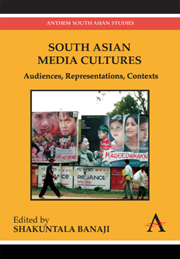Book contents
- Frontmatter
- Contents
- List of Illustrations
- 1 Introduction
- Part One Elaborating Audiences: Meaning, Use and Social Context
- Part Two Telling Texts: Media Discourse, Identity and Politics
- 6 Private Satellite Media and the Geo-Politics of Moderation in Pakistan
- 7 Forgetting to Remember: The Privatisation of the Public, the Economisation of Hindutva, and the Medialisation of Genocide
- 8 Myth – The National Form: Mission Istanbul and Muslim Representation in Hindi Popular Cinema
- 9 A Peace of Soap: Representations of Peace and Conflict in Popular Teledramas in Sri Lanka
- 10 Destigmatising Star Texts – Honour and Shame among Muslim Women in Pakistani Cinema
- Part Three Alternative Producers: The Articulation of (New) Media, Politics and Civic Participation
- List of Contributors
9 - A Peace of Soap: Representations of Peace and Conflict in Popular Teledramas in Sri Lanka
from Part Two - Telling Texts: Media Discourse, Identity and Politics
Published online by Cambridge University Press: 05 March 2012
- Frontmatter
- Contents
- List of Illustrations
- 1 Introduction
- Part One Elaborating Audiences: Meaning, Use and Social Context
- Part Two Telling Texts: Media Discourse, Identity and Politics
- 6 Private Satellite Media and the Geo-Politics of Moderation in Pakistan
- 7 Forgetting to Remember: The Privatisation of the Public, the Economisation of Hindutva, and the Medialisation of Genocide
- 8 Myth – The National Form: Mission Istanbul and Muslim Representation in Hindi Popular Cinema
- 9 A Peace of Soap: Representations of Peace and Conflict in Popular Teledramas in Sri Lanka
- 10 Destigmatising Star Texts – Honour and Shame among Muslim Women in Pakistani Cinema
- Part Three Alternative Producers: The Articulation of (New) Media, Politics and Civic Participation
- List of Contributors
Summary
Introduction
It is 8.30 pm in Sri Lanka. The prime time television slot, immediately after the Sinhala News on Rupavahini, the State Television channel, is usually reserved for viewing the most popular teledramas. Families across the country sit together expecting images of ‘reality’ to bombard their screens. In the last twenty years, ‘bombard’ has taken on many connotations, as television producers/directors, actors and actresses attempt to capture the two crucial trajectories that have shaped the fabric of the nation: war and peace, that Sri Lanka has endured for the last three decades.
Although this has now broken down irrevocably in 2008–9, a de-escalation of the ethnic conflict and a temporary ceasefire agreement in 2002 between the Government of Sri Lanka (GoSL) and the Liberation Tigers of Tamil Eelam (LTTE) created a tenuous peace. After the Peace Accord, the mood of euphoria was contagious and everyone jumped on the ‘peace bandwagon’, including the television industry. An exploration of selected episodes from two popular teledramas that were scripted and screened during the ceasefire is a conduit to uncovering the political meanings underlying messages of peace in popular television. These messages need to be contextualised in relation to the larger discourses of nationhood within which peace is circulated and established in the public consciousness.
In this chapter, I will argue that the configurations of peace in television not only resonate closely with the dominant public and political discourses, but also invoke and are inscribed by discourses of identity, and racial and cultural purity, that have marked the ideological terrain of the ethnic conflict in Sri Lanka thus far.
- Type
- Chapter
- Information
- South Asian Media CulturesAudiences, Representations, Contexts, pp. 163 - 180Publisher: Anthem PressPrint publication year: 2010



